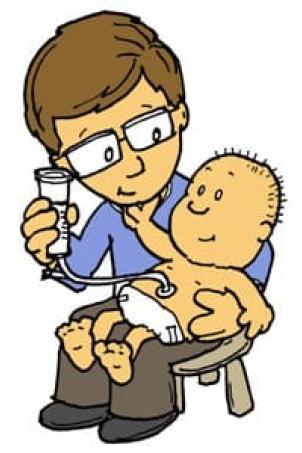
Expert Tips on Troubleshooting Your Child’s Gastrostomy Tube (G-tube)
Most of my posts cover topics that impact the majority of parents. But, for this post, I want to give a little extra support to parents who have kids with gastrostomy feeding tubes (G-tubes). The needs of this community are extra special.
Making sure your child eats and gets enough nutrients is an important part of being a parent. Yet, the feeding demands of a child with G-tube place a special set of requirements on parents. A 2010 research article found a surprising finding: parents of children fed by G-tubes report higher stress levels than parents of children with diabetes or growth deficiencies. The authors believed the higher stress levels were related to the constant demands of day-to-day feeding and caring for their child’s G-tube. I and a few of my colleagues would like to help reduce the stress of caring for your child’s G-tube and offer troubleshooting tips. I consulted with nurse practitioner experts in Children’s Hospital Los Angeles Pediatric Surgery, wound ostomy nurse and a clinical care coordinator to bring you the insights and guidance below.
Please keep reading and share this with other parents that care for their child’s G-tube.
How You Can Help If Something is Wrong With Your Child’s G-Tube

Check the water balloon; it should have the correct amount of fluid. The amount of fluid will vary depending on the child. If the balloon is lacking in fluid, fill it with water until it reaches the correct amount. G-tube Came Out First, don’t panic. Cover the site with gauze and tape and replace with the tube if you have been trained to insert one in case the tube comes out. The gauze and tape will protect your child’s skin from the acidic stomach juices and keep it clean and dry. If you have not been instructed to insert a tube, call your Pediatric Surgery or Gastrointestinal Specialist. You may be instructed to go to the clinic where your child routinely gets checked or the Emergency Department (ED). Your practitioner will advise you where you should go in case this happens. If your child has a PEG tube placed by the GI specialists, you will likely be instructed to go to the ED. If your child has a G-tube placed by pediatric surgery, you will likely be instructed to go the clinic if the tube comes out during clinic hours.
G-tube is in Too Deep
Our experts recommend writing down the size and brand name of your child’s G-tube, the measurement outside the body and name of the physician who inserted it. To avoid the G-tube going in too deep, check your child’s G-tube measurement daily. If you find the tube is too deep, pull back to desired the length. The desired length will vary, which is why it’s important to write down the size of your child’s G-tube. If you have difficulty pulling the G-tube back, stop and call your child’s health care specialist.
G-tube is Clogged Our first recommendation is to use a syringe and push a small amount of lukewarm water into the tube to clear the clog.
For established G-tube sites: Remove the tube and insert a new one if you have been trained to do so by your health care specialist.
For new G-tube sites: If lukewarm water does not work, take your child to their GI specialist or call your child’s health care specialist. It’s important to remember that objects should never be pushed into the G-tube to try and unclog.
G-tube is Leaking Here are some simple steps to get leaking under control:
- Check the water balloon; it should have the correct amount of fluid. The amount of fluid will vary depending on the child. If the balloon is lacking in fluid, fill it with water until it reaches the correct amount.
- Check the tube.
- Place a rubber band around the disk.
- Make sure you allow your child to burp or vent after feeding.
- Slow down or stop the feed.
- Clamp your child’s G-tube between feeds to prevent leakage.
- Use gauze to protect your child’s skin from the acidic stomach juices and to keep the site clean and dry.
- A special barrier cream may be needed around the G-tube site. We recommend speaking with your health care specialist.
G-tube Drainage and/or Redness
If your child’s G-tube has drainage other than formula, stop the feeding and call your child’s health care specialist as soon as possible.
Our health care specialists have a wealth of information and are a great resource for information about G-tubes. If you are at Children’s Hospital Los Angeles, I recommend visiting our Family Resource Center for helpful hand-outs about caring for your child’s G-tube at home. There is a very informative two-hour G-tube class that you can take at Children's Hospital Los Angeles, call the Family Resource Center at 323-361-7698, to register. This class focuses on care of the child with the G-tube. We hope you find this blog post helpful and that it releases some of the stress from the constant demands of day-to-day feeding and caring for their child with a G-tube. We are here to help!
Thank you to Tere Jones, RN, CPN, for her collaboration on this blog post.


